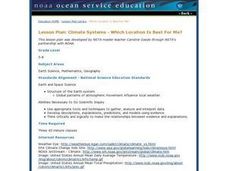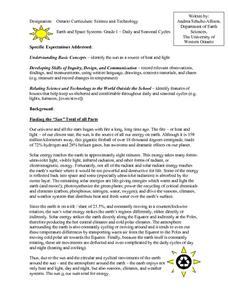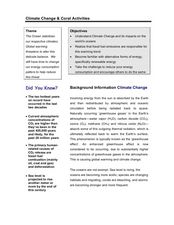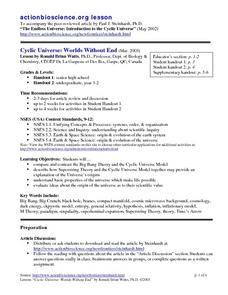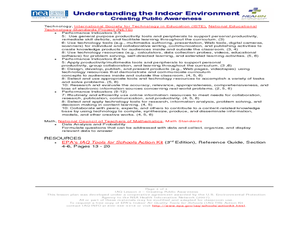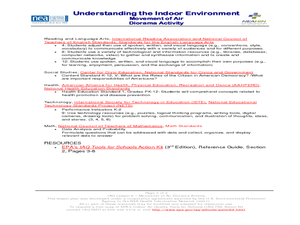Curated OER
Discovering a Law of Space Physics
Learners use data collected by an astronomer to determine the relationship between the time it takes the planet to orbit the sun and the average radius of the planet's orbit around the sun. Students use trial and error to find the...
Curated OER
Climate Systems - Which Location Is Best For Me?
Students study the difference between weather and climate. In this climate systems lesson students search the Internet for the parts of the Earth's system, gather climate data and complete a challenge scenario.
Curated OER
Daily and Seasonal Cycles
First graders identify the sun as a source of heat and light. They identify features of houses that help keep use sheltered and comfortable throughout daily and seasonal cycles. Students are told that summer is the best season to...
Curated OER
Plate Tectonics
Students research separate elements of the theory of Plate Tectonics, then share that information with each other, drawing conclusions from the culminated information.
Curated OER
Rocks, Minerals, and Erosion
Fourth graders describe the difference between minerals (composed of the same substance throughout) and rocks (composed of two or more minerals). They recognize that there are three classes of rocks: igneous, sedimentary, and metamorphic
Curated OER
Structures and Behaviors of Planarians
Students investigate planaria of the phylum platyhelminthes. They use DigiScope technology to observe and describe the structure and movements of planarians.
Curated OER
Sweet Candy Comets
Fourth graders use candy to make a comet. In this lesson, 4th graders examine the role comets have played throughout history, students watch NASA videos about comets and complete the lesson by making an edible model of a comet. This...
Curated OER
Climate Change & Coral Activities
Students study how the ocean stabilizes our planet's climates and how global warming is becoming a threat to this fine balance. In this climate change instructional activity, students identify that fossil fuel emissions are responsible...
Curated OER
Galaxies
Tenth graders explore the structure and content of galaxies. Through discussion, lab, and hands-on activities, they discover the general structure of the three types of galaxies as well as the effect they have on the structure and...
Curated OER
Matter in Motion
Second graders examine matter, what it is and what the different states are. In this matter activity students view The Magic School Bus Meets Molly Cule and answer questions.
Curated OER
Volcanoes And Atmospheres
Students identify the volcano as the primary source of atmospheric gases, to explain the formation of ozone, and to recognize the dangers of volcanic gases through the use of technology in the classroom.
Curated OER
Our Universe: Designed or Evolved?
Students brainstorm and write arguments for Evolution and Intelligent Design. They research the history of each of these ideas. They also examine the controversy of teaching one or both ideas in schools.
Curated OER
Mountaintop Removal Coal Mining
Students become familiar with coal as an energy source and how it is mined. In this coal lesson plan, students research the effects of coal mining on the environment. Students discuss the various problems associated with coal mining....
Curated OER
Cyclic Universe: Worlds Without End
Students compare and contrast the Big Bang Theory and the Cyclic Universe Model. They explain basic properties of the univers which make life possible. They evaluate ideas about the origin of the universe as to their scientific value.
Curated OER
Using Triangulation to Locate Meteorites from Witnessed Falls
High schoolers participate in a mock investigation in which they must interview and record data given by 3 people ("witnesses") in an effort to triangulate the location of a meteorite.
Curated OER
Getting to Know Soil
Students make predictions and analyze soil. In this soil properties lesson, students make predictions about soil properties for various soil samples. Students examine the types of soils and record their observations. Students analyze...
Curated OER
Exploring Big Bang Evidence
Ninth graders study the Big Bang theory. In this big bang theory lesson students research the Internet and complete several activities and create a presentation.
Curated OER
Using the Very, Very Simple Climate Model in the Classroom
Students study the relationship between the average global temperature and carbon dioxide emissions. In this weather lesson students develop a test scenario using a model then read and interpret graphs of data.
Curated OER
Ocean Botttom Profile
Students interpret a graph of ocean depths and topographic features. This task assesses students' abilities to interpret figures, organize and represent data, apply knowledge of scale to a profile, and apply theoretical knowledge.
Curated OER
Creating Public Awareness - Indoor Air Quality
Students design a poster about indoor air quality. In this indoor air quality lesson, students make a billboard that tells the occupants of a building about at least one air quality problem.
Curated OER
Using the Problem Solving Wheel
Students solve problems about air quality. In this air quality lesson, students receive a scenario from the problem wheel and find solutions to the air quality problem. Students write a paragraph summarizing what they learned.
Curated OER
Movement of Air Diorama Activity
Learners make a diorama to illustrate the process of mechanical airflow. In this movement of air lesson plan, students discuss ventilation and air movement indoors. Learners discuss ventilation systems and study pictures of the systems....
Curated OER
Movement of Air Mind Map Activity
Students explore the movement of air. In this air lesson, students discuss and give examples of air ventilation. Students compare outdoor and indoor air quality. Students create mind maps as a visual representation of what they have...
Curated OER
Understanding the Indoor Environment: The Movement of Air
Young scholars discuss HVAC to assess prior knowledge. Students create a rubric to assess their modals of HVAC units, and build the models according to instructions and discussion by the teacher.



